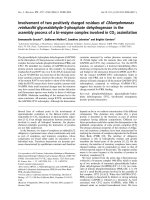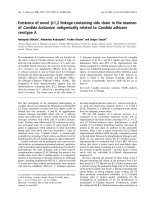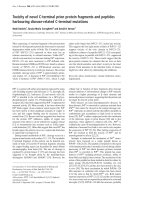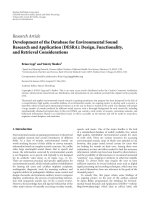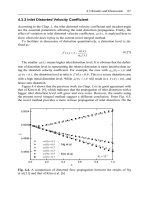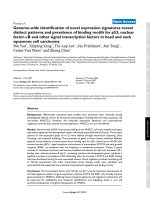Development of novel positively charged single isomer cyclodextrins and applications in enatiomeric separation and chiral synthesis
Bạn đang xem bản rút gọn của tài liệu. Xem và tải ngay bản đầy đủ của tài liệu tại đây (930.85 KB, 187 trang )
1
Chapter 1 Introduction
1. 1 Chiral separation: need and perspective
Stereoisomers are isomeric molecules with an identical constitution but a different spatial
arrangement of atoms. The symmetry factor classifies stereoisomers as either
diastereoisomers or enantiomers. Diastereoisomers are stereoisomers not related as mirror
images. If the stereoisomers are mirror images of one another but are not superimposable,
they are called enantiomers [1, 2]. An example of such diasteroisomers and enantiomers
are shown in Figure 1. 1.
CC
CH
3
H
3
C
H
H
CC
CH
3
H
3
C
H
H
Cis-2-butene
Trans-2-butene
H
OH
COOH
HO
H
H
3
C
HOOC CH
3
(R)-lactic acid
(S)-lactic acid
m
i
r
r
o
r
plane
Diastereoisomers
Enantiomers (● denotes the chiral center)
Figure 1. 1. Stereochemical structures of the pair of diasteroisomers and enantiomers
The property of nonsuperposability is termed as chirality and the structural feature that
gives rise to this asymmetry is called chiral center (also called as sterogenic center or
asymmetric center). Usually, carbon is not the only atom to act as chiral center.
Phosphorus, sulfur and nitrogen are among the other atoms that form chiral molecules.
Enantiomers usually display similar chemical and physical properties at nomal conditions,
except for the direction in which they rotate the plane-polarized light. The respective
2
enantiomer will have a different sign for optical rotation, which can be a (+) or (-). An
alternative description system fro the direction of rotation is that of dextrotary (d) or
laevorotatory (l). However, the terms d and l, and (+) and (-) only donate the direction in
which plane-polarized light is rotated and tell us nothing about the absorlute
stereeochemical arrangement of the atoms in the molecules. A nomenclature to distinguish
between the three-dimensional arrangements of the atoms at a stereogenic centre has been
devised by Cahn, Ingold and Prelog [3]. Absolute configurations are denoted as R or S
according to the sequence rule.
Chirality has attracted great attention because living systems are chiral. Amino acids,
proteins, nucleic acids, and polysaccharides possess chiral characteristic structures that are
closely related to their functions. In nature, these biomolecules exist in only one of the two
possible enantiomeric forms, e.g., amino acids in the L-form and sugars in the D-form.
Due to the fact that many of the building blocks in the body are chiral, molecules and
many receptors in the body act as enantiodiscriminating processes. As a consequence,
metabolic and regulatory processes mediated by biological systems are sensitive to
stereochemistry and different responses can be often observed when comparing the
activities of a pair of enantiomers. Stereoselectivity is often a characteristic feature of
enzymatic reactions, messenger–receptor interactions and metabolic processes; it can vary
interspecifically and even from one individual to the other [4-7]. Therefore,
stereochemistry has to be considered when studying xenobiotics, such as drugs,
agrochemicals, food additives, flavors or fragrances.
The interest in chirality and its consequences is not a new phenomenon. However,
increasing expectations have risen until the last decade due to scientific and economic
reasons, with the pharmaceutical industry being the main contributor and driving force
3
[8-10].
Enantiomers of a racemic drug (a mixture of two enantiomers) may have different
pharmacological activities, as well as different pharmacokinetic and pharmacodynamic
effects. Since the human body is amazingly enantioselective, it will interact with each
enantiomer of a racemic drug by a separate pathway to produce different pharmacological
activity. Thus, one isomer may produce the desired therapeutic activities, while the other
may be inactive or, in worst cases, produce unwanted effects [11, 12]. A typical example
for the first case is epinephrine. The (-)-epinephrine, a sympathomimetic drug used for
cardiac stimulation, is ten times more potent than its isomer [(+)-epinephrine] [13]. A
particularly tragic example attributed to chirality occurred in the early 1960’s when
synthetic tranquilizer thalidomide was widely prescribed as a sedative. It was used by
some pregnant women who later gave birth to deformed children [14]. The number of
such examples is of course large, and consequently the need for enantiopure drugs is an
important matter.
Despite the fact that scientists have been fully aware of these differences for more than
two decades, the main advances in the development of enantiomerically pure compounds
have been accomplished in the last decades with the prosperity of new asymmetric
synthesis methodologies, and powerful analytical and preparative separation techniques
[15, 16]. Many enantiomerically pure drugs have successfully reached the market.
Therefore, health and regulatory authorities, such as the US Food and Drug
Administration (FDA), have defined more strict requirements to patent new racemic drugs,
demanding a full documentation of the separate pharmacological and pharmacokinetic
4
profiles of the individual enantiomers, as well as their combination [5, 16-19]. In addition,
a rigorous justification is required for market approval of a racemate of chiral drugs.
Single enantiomer drug sales have shown a continuous growth worldwide since 1996 and
many of the top-selling drugs are marketed as single enantiomer (Figure 1. 2) [20, 21].
The chiral drug industry soared through a major milestone in 1999, as annual sales in this
rapidly growing segment of the drug market topped $100 billion for the first time [22].
Worldwide sales of chiral drugs in single-enantiomer dosage forms continued growing at a
rate of more than 13% annually to $133 billion in 2000. At a future growth rate estimated
by Technology Catalysts International Corporation (TCI), the figure could hit $200 billion
in 2008. In a second growth trend, according to the firm, 40% of all dosage-form drug
sales in 2000 were of single enantiomers [21-23].
Figure 1. 2. Worldwide Sales of single enantiomeic drugs until 2003 and expected for the
year 2005.
5
Researchers and economic analyzers are very confident that the chiral drug industry will
continue to spur strong growth because of the efforts to improve drug efficacy and to cut
development costs in the face of regulatory pressures. Therefore, the importance of
determining and purifying the stereoisomeric composition of chemical compounds,
especially those of pharmaceutical significance, will be more clearly recognized and
emphasized [24]. Consequently, applicable and practical techniques to obtain the
enantiopure compounds are a must.
Although a number of stereoselective syntheses have been described and applied to the
production of single enantiomers [25-27], relatively few are selected for large-scale
preparations, especially at the early stage of developing new drugs. The development of
asymmetric synthesis would be expensive and time consuming and thus, analytical
techniques for chiral separation of enantiomers have great potential.
1. 2 Techniques for chiral separation
Enantiomers can be separated either by direct or indirect separation methods. The indirect
separation method is based on the formation of a covalent bond between the optical
antipodes on the one hand and a pure chiral compound, called the chiral selector, on the
other hand. This chemical reaction will result in a product consisting of two isomeric
compounds which are not mirror images anymore. They are known as diastereoisomers
and they can, in principle, be separated by any analytical method using an achiral
separation mechanism. This method is, first of all, time consuming since sample
pretreatment involving a chemical reaction is necessary. Secondly, the chiral selector has
to be very pure, since optical impurity will result in two more diastereomeric products.
6
In direct separation mode, the separation of optical isomers is based upon complex
formation between the enantiomers and a chiral selector, resulting in the formation of
labile diastereoisomers. Separation can be accomplished if the complexes possess different
stability constants. The above mentioned disadvantages of indirect separations can be
avoided by direct separation mode. The chiral purity of the selector only influences the
resolution. It has been shown that relatively good results can be obtained using a chiral
selector containing up to 10% of its antipode [28].
Analytical methods used so far for the direct enantiomeric separation include high
performance liquid chromatography (HPLC) [29-31], thin-layer chromatography (TLC)
[32], gas chromatography (GC) [33], supercritical fluid chromatography (SFC) [34], and
capillary electrophoresis (CE) [35-48]. The application of gas chromatography is mainly
restricted to more volatile compounds. Therefore, until now, the method for the separation
of more polar compounds and most drugs is HPLC. The main drawback of CE compared
to HPLC is that until now, CE has not been shown to be useful as a preparative separation
tool. Another advantage of HPLC over CE is the low detection limit, due to the much
longer path length of the detection cell and the much higher injection volume. However,
the very high efficiencies usually obtained in CE, and the ease of method development,
make it a good alternative for analytical separation of enantiomers. Other advantages of
CE over HPLC are the low consumption of both analyte and chiral selector and the short
analysis times. Moreover, CE does not require the use of expensive chiral stationary
phases, since the chiral selector is simply added to the buffer. Alternatively, CE might be
very useful for the rapid screening of novel chiral selectors, thus avoiding the waist of the
7
laborious synthesis of new chiral HPLC stationary phases.
1. 3 History and development of capillary electrophoresis
Capillary electrophoresis was evolved from eletrophoresis. Electrophoresis is the
separation principle in which charged particles or molecules are separated under the
influence of an external electric field. Already at the beginning of the last century, Von
Reuss performed the first electrophoretic experiments [49]. Exactly 100 years ago,
Kohlrausch developed his regulating functions [50], which made it possible to
theoretically describe all electrophoretic methods. Electrophoresis has, since then, been
mainly applied for the separation of large biomolecules like DNA and proteins, using
stabilizing and sieving media such as gels. The introduction of narrow bore tubes as an
anti-convective medium made it possible to use free solutions instead of these gels.
Hjertén described the use of a rotating quartz capillary of 3 mm inner diameter (I.D.) [51].
Smaller I.D. capillaries were successfully applied by Everaerts [52] and Virtanen [53].
The reduction of the I.D. allowed the use of higher electric field strengths, resulting in
higher efficiencies and shorter times of analysis. Mikkers et al. [54, 55] showed that the
high efficiencies, theoretically described by Giddings [56], could be achieved. Jorgenson
[57] used 75 μm I.D. glass capillaries, in which longitudinal diffusion was shown to be
practically the only source of band broadening. This important breakthrough became the
milestone in the development of modern capillary electrophoresis (CE). The next
important achievement was the introduction of capillary micellar electrokinetic
chromatography (MEKC) by Terabe and his co-workers in 1984 [58-60]. This technique
owes its migration principle to electrophoresis and its separation principle to
8
chromatography. The application range of CE techniques was expanded to neutral
compounds by this outstanding innovation.
Capillary electrophoresis has since then proven to be a highly efficient, analytical
separation tool, not only for the separation of macromolecules but also for smaller
molecules. Fundamental studies as well as numerous applications have been reported in
the last decade. Numerous books [61-70] and a number of review papers [71-72]
summarized the history and applications of capillary electrophoresis.
It is without doubt that such a powerful microseparation technique as modern CE owes a
lot to other analytical techniques such as slab gel electrophoresis, capillary gas
chromatography and high-performance liquid chromatography.
1. 3. 1 Principle of electrophoresis
Electrophoresis is a separation process involving in the migration of charged particles in a
gel slab or buffer solution under the influence of an electric field. Ionic and ionizable
solutes are separated based on differences in charge, size and shape. When a charged
particle is placed in an electric field, it experiences a force which is proportional to its
effective charge (q) and the electric field strength (E). The translational movement of the
particle is opposed by a viscous drag force which is proportional to the particle velocity
(V), hydrodynamic radius (r) and medium viscosity (η). When the two forces are
counterbalanced, the particle moves with a steady state velocity [57, 73, 74]:
EV
eleele
μ
= Eq. 1.1
where E is the applied voltage per unit column length (L), and μ
ele
is the electrophoretic
9
mobility given by:
r
q
ele
πη
μ
6
= Eq. 1.2
Electroosmosis (Figure 1. 3) in capillary tubes, on the other hand, refers to the propulsion
of the bulk solvent in the tube under the influence of an applied electric potential. The
silica surface consists of Si-OH groups which are ionized to SiO
-
in alkaline and slightly
acidic media (pH>2). The negatively charged surface is counterbalanced by positive ions
from the buffer and a double layer is formed. Under the influence of an applied potential
the positive ions in the diffusion region migrate towards the cathode and in doing so they
entrain the water of hydration, resulting in electroosmotic flow. The equations of
electroosmotic flow are identical to those developed for electrophoretic migration since
both phenomena are complementary. The electroosmotic velocity (V
eof
) is given by:
EV
eofeof
μ
= Eq. 1.3
ζ
πη
ε
μ
4
=
eof
Eq. 1.4
where
eof
μ
is the electroosmotic mobility, ε is the dielectric constant of the soloution,
and
ζ
is zeta potential.
eof
μ
depends, to a large extent, on the magnitude of the zeta
potential at the capillary wall-bulk buffer interface. The zeta potential is largely dependent
on the electrostatic nature of the wall surface and, to a smaller extent, on the ionic nature
of the buffer.
10
Figure 1. 3. Illustration of electroosmotic flow in capillary. [75]
Electroosmotic flow is directly proportional to the zeta potential and for untreated
capillary walls and it generally decreases with decreasing pH, because the hydrogen ions
deactivate the column surface causing a decrease in the zeta potential. At moderate pH
values (pH>3), the electroosmotic flow with the untreated capillary column is generary
higher than the electrophoretic flow that causes all solutes (cationic, neutral and anionic)
to migrate toward the detection end of the column (usually at the cathode). Cationic and
anionic solutes are separated based on differential electrophoretic migration while neutral
solutes co-migrate with the electroosmotic flow velocity and are not separated.
1. 3. 2 Modes of capillary electrophoresis [76-78]
The basic modes of capillary electrophoresis are capillary zone electrophoresis (CZE),
micellar electrokinectic chromatography (MEKC), capillary gel electrophoresis (CGE),
capillary electrochromatography (CEC), capillary isotachophoresis (CITP) and capillary
isoelectric focusing (CIEF).
The most popular and widely applied mode is capillary zone electrophoresis (CZE). The
11
separation by this technique is based on the different electrophoretic mobilities of the
analytes in background electrolyte (BGE) under the effect of an electric field. This
difference can be caused by different charges, masses or structure of chemical compounds.
A high value of the EOF allows the separation of both anions and cations in one single run,
using CZE in moving boundary electrophoresis.
In moving boundary electrophoresis, the separation system is filled with a so-called
leading electrolyte. The sample is introduced at the beginning of the separation
compartment. After applying the voltage, the most mobile analyte will form a pure zone,
followed by a mixed zone consisting of the most mobile and the second most mobile
analyte. According to the Kohlrausch regulation function [50], the concentration of the
components in the zones is adapted to the concentration of the leading electrolyte. The
boundaries between the zones have self-correcting properties, due to differences in electric
field strength between the zones. The boundary between the leading zone and the first
pure zone can be considered as an isotachophoretic boundary. In a single run, moving
boundary electrophoresis is only applicable to either anions or cations.
1. 4 Chiral selectors in capillary electrophoresis
The success of chiral separation by CE will be greatly dependant on the correct choice of
chiral selector. The chiral selector will, in most cases, be added to the BGE. The
separation of the optical isomers is based upon complex formation between the
enantiomers and a chiral selector, resulting in the formation of labile
diastereoisomers.
Separation can be accomplished if the complexes possess different stability constants. The
12
addition, however, of a chiral selector to an electrophoretic system does not guarantee the
successful separation of all optical isomers. The most important rule for chiral recognition
is that the chiral selector must be compatible in size and structure to the racemate; a
minimum of three molecular interactions has to occur. These interactions can be both
attractive and/or repulsive. Possible modes of interaction include: ion-ion bonds,
dipole-dipole bonds like hydrogen bonds, Van der Waals forces and Ion-dipole bonds.
Furthermore, only one of the two enantiomers needs to interact with the chiral selector via
the three-point minimum mode. Not all interactions between the chiral selector and the
solute will meet this criterion; also achiral interactions will occur. In these cases,
separation optimization should be accomplished by maximizing the 3-point ‘chiral
interactions’ at the expense of the non-chiral interactions [79, 80].
To achieve successful enantioseparations by CE, the chiral selector used is quite crucial.
An effective chiral selector must meet several requirements, namely: (a) it should be
stereoselective and form a transient diasteromeric complex with each enantiomer; (b) it
should be soluble and chemically stable in the BGE; (c) it should not interfere with the
detection; and, (d) it should exhibit fast complexation kinetics.
The commonly used chiral selectors in CE are depicted in Figure 1.4. Cyclodextrins (CDs)
are by far the most popular chiral selectors used in CE and will therefore be discussed in
more detail than the other chiral selectors mentioned in this section. The detailed
description about cyclodextrin will be provided in the following Section 1.5.
13
Chiral Selectors in CE
Macrocyclic
antibiotics
Crown
ethers
Ligand
exchange
complexes
Polysaccharides
Proteins
Micelles
Selectors based on natural and synthetic polymers
Native cyclodextrins
and derivatives
Metalic
complexes
Figure 1. 4. Different types of chiral selectors used in CE.
Crown-ethers are macrocyclic polyethers capable of forming host-guest complexes with
inorganic and organic cations. Modification of the crown ether by the introduction of four
carboxylic groups makes it possible to use this class of compounds as chiral selectors in
CE. The crown-ether can incorporate protonated primary amino compounds by formation
of ion-dipole bonds with the oxygen atoms of the chiral selector (Figure 1.5). The chiral
crown-ether (18-crown-6-ether tetracarboxylic acid) can be used for the chiral separation
of several basic compounds [81].
14
Figure 1. 5 Structure of the complex formed between 18-crown-6 and a protonated
primary amino compound.
Macrocyclic antibiotics are a new, very promising class of chiral selectors. Vancomycin,
rifamycin B and ristocetin A have proven to be highly selective towards the enantiomers
of a broad class of compounds [82, 83]. These antibiotics are amphilytic, and are strong
UV-absorbers. However, in most cases, detection of the analytes is not disturbed by the
high background absorption of the chiral selector since only very low concentrations of
the antibiotics are needed. The chiral recognition is obtained mainly by charge-charge
interactions, hydrogen bonding, hydrophobic inclusion and π-π interactions. These
interactions can be either attractive or repulsive.
Proteins also have been applied successfully as chiral selectors in CE. One of the
characteristics of proteins is the isoprotic and the isoelectric point, pI. The protein will be
positively charged if pH < pI, and negatively charged if pH > pI. This indicates that the
pH will be a very important operating parameter for the optimization of chiral selectivity.
Similar to the charged CD-derivatives, it is possible to separate both charged and
uncharged species using this chiral selector. Among the many proteins used as chiral
selector in CE, bovine serum albumin (BSA) is most widely applied [84, 85]. The
mechanism, involved in chiral recognition is comparable with that of macrocyclic
15
antibiotics.
Chiral surfactants were first used by Terabe’s group as micellar phase for the separation of
non-charged compounds [86] and optical isomers, using Micellar electrokinetic
chromatography (MEKC) [58]. Both natural surfactants such as bile salts, as well as
optically active amino-acid derived synthetic surfactants have been used as chiral selector
in CE. New chiral surfactants often have a low critical micelle concentration, are highly
soluble and can be synthesized in both the L- and D-form [87]. The last feature makes it
possible to easily change the migration order of the optical isomers. For the determination
of the optical purity of e.g. drugs, it is highly favorable that the minor component migrates
in front of the major component.
Many other classes of compounds have also been used as chiral selectors in CE. The most
important group, not mentioned so far, is probably the oligosaccharides consisting of
maltodextrin, heparin and dextran sulphate. Some recent comprehensive reviews give an
excellent survey on the state of the art of chiral separations in CE [88, 89, 90]. We do not
want to repeat it here.
1. 5 Cyclodextrins: the chiral selector for CE
Cyclodextrins represent the most frequently used chiral selectors in CE. Native CDs are
cyclic oligosaccharides consisting of six (α-CD), seven (β-CD) or eight (γ-CD)
glucopyranose units with a truncated cone providing a hydrophobic cavity. These CDs can
only exhibit modest chiral discrimination to very limited racemate pool. According to the
review by Gübitz [91], only 15% of the compounds listed in the review can be resolved.
16
Such a low enantioselectivity can be ascribed to their inherent symmetry according to
Easton [92].
Increased chiral discrimination can thus be expected from the use of modified CDs with
an increased asymmetry. The hydroxyl groups on the rims of native CDs can be modified
to obtain CDs in variable degrees of substitution. The hydroxyl substituents can be
replaced at random to obtain a complex mixture of isomers where the overall effect is that
of a symmetric distribution. Therefore, this type of substitution does not alter the
symmetry or enantioselectivity of the CD. The other type of modification has arisen from
a new trend to producing selectively substituted derivatives, usually called single-isomers.
This may induce changes in the asymmetry of the CD and increase enantioselectivity as a
result. This modification of native CDs can lead to neutral or charged CDs [93]. The use
of CDs as chiral selectors is the subject of several selective reviews [46, 90, 93, 94, 95].
1. 5. 1 Naturally occurring cyclodextrins
Cyclodextrins (CDs) are torus shaped cyclic D-gluco-oligosaccharides produced from
starch by enzymatic degradation. Although CDs containing between 6 to 12
D(+)-glucopyranose units have been isolated, only those containing 6 (α-CD), 7 (β-CD) or
8 (
γ-CD) residues are currently used.
17
O
OH
OH
HO
O
O
HO
OH
HO
O
O
HO
HO
OH
O
O
HO
HO
OH
O
O
OH
HO
OH
O
O
O
OH
OH
HO
O
HO
OH
OH
O
O
HO
OH
OH
O
HO
HO
OH
O
O
OH
HO
OH
O
O
O
OH
HO
HO
O
O
OH
OH
HO
O
O
OH
OH
HO
O
O
HO
OH
OH
O
HO
OH
OH
O
O
HO
HO
OH
O
O
HO
HO
OH
O
O
OH
HO
OH
O
O
O
OH
HO
HO
O
O
OH
OH
HO
O
OH
OH
HO
O
O
α-CD β-CD γ-CD
a) Molecular structure of cyclodextrins
Rim of
Secondary
Hydroxyls
Hydrophobic
cavity
Rim of
Primary
Hydroxyls
b) Schematic representation of the cyclodextrin torus
Figure 1. 6. Structure of Cyclodextrins
In general, a cyclodextrin molecule can be briefly described as a torus, but is somewhat
more realistically pictured as a shallow truncated cone possessing multiple stereogenic
centers with a partially blocked base, a hydrophobic interior cavity and hydrophilic edges
due to the presence of hydroxyl groups. All the glucose units in this toroidal structure are
in their chair-conformation. The interior of the CD cavity is relatively hydrophobic, while
the outside rim is more hydrophilic [96, 97]. The rim on the wider side of the CD cavity
contains the chiral secondary hydroxyl groups, while the opposite smaller opening is
occupied by achiral primary hydroxyl groups.
OH
CH
2
OH
OH
0.79 nm
2
3
6
~0.38 nm
α 0.49 nm
β 0.62 nm
γ 0.79 nm
18
Figure 1.6(a) shows the structures of α-, β- and γ-CD, while the dimensions are
schematically shown in Figure 1.6(b). The size of the hydrophobic cavity is such that, in
general, the α-CD can accommodate a single phenyl ring, while β-CD and γ-CD can
accommodate substituted single and multiple ring systems. This inclusion alone is not
enough for chiral recognition: interaction between substituents on the asymmetric center
of the analyte and the hydroxyl groups on the CD-rim are responsible for chiral
recognition. Some physical properties of these three CDs are quite different (as shown in
Table 1.1) [98-102].
Table 1. 1. Some Physical and chemical properties of native cyclodextrins
α-cyclodextrin
β-cyclodextrin
γ-cyclodextrin
Number of glucose units 6 7 8
Formula (anhydrous) C
36
H
60
O
30
C
42
H
70
O
35
C
48
H
80
O
40
Molecular weight 972.85 1134.99 1297.12
Approximate cavity volume (nm
3
) 1.74 2.62 4.27
α
D
(deg.)
+150.5 +162.0 +177.4
pKa (25
o
) 12.33 12.20 12.08
Solubility(g/100ml water, 25
o
C) 14.5 1.85 23.2
CDs are able to be regarded as “hosts” for “guest” molecules capable of entering (in whole
or in part) the cavity and forming noncovalent host-guest inclusion complexes. Almost all
applications of CDs involve complexation. The mechanism of inclusion complexation in
CE is schematically shown in Figure 1.7. Inclusion complex formation and the size of
the analyte’s binding constant to the cyclodextrin are determined by several different
factors. The most important factors are the ‘hydrophobic effect’, which induces the apolar
19
portion of the molecule to preferentially reside in the cyclodextrin cavity, and hydrogen
bonding between appropriate polar segments of the guest molecule and the secondary
hydroxyl groups at the mouth of the cyclodextrin cavity. Other factors which can
influence complex formation are Van der Waals interactions, release of high energy water
from the CD cavity and a change in ring strain upon complexation.
CD
Cation
Anion
EOF
Anode
Cathode
Neutral
Figure 1. 7 Schematic representation of the mechanism of inclusion complexation with
neutral cyclodextrins in CE.
1. 5. 2 Neutral cyclodextrins
According to the statistic data surveyed in several representative reviews [37, 46, 91],
native cyclodextrins can resolve a very limited number of chiral compounds with modest
chiral discrimination. Among the commonly used native CDs, β-CD with suitable
dimension of hydrophobic cavity, has been applied to the analysis of a wider range of
chemical compounds especially of pharmaceutical interest. However, its low aqueous
solubility as shown in Table 1. 1, often presents a limitation in certain applications.
The improvement of enantioselectivity of native CDs and their solubility in certain
solvents such as water, ethanol and methanol can be achieved by modification of
cyclodextrins. When the hydroxyl groups on the rims of native CDs are selectively
20
replaced by neutral groups such as methyl, acetyl, hydroxyethyl, hydroxypropyl and
cyanoethyl [37, 91, 103-105, 106], various neutral CDs can be obtained. The commonly
used neutral CDs are hepatakis-O-methyl-β-CD (M-β-CD), hepatakis(2,
6-di-O-methyl)-β-CD (DM-β-CD), hepatakis(2, 3, 6-tri-O-methyl)-β-CD (TM-β-CD) and
hydroxypropyl-β-CD (HP-β-CD).
The first attempt to perform chiral separation using modified cyclodextrins by CE was by
the group of Smolkova-Keulemansova [107]. They used isotachophoresis (ITP) with the
addition of DM-β-CD and TM-β-CD to the leading electrolyte for the resolution of
ephedrine alkaloid enantiomers. Hydroxypropylated CD’s (HP-α-CD, HP-β-CD or
HP-γ-CD) were applied for the enantiomeric resolutions of some chiral pharmaceuticals
containing the imidazole (1, 3-diazole) moiety [108]. The above mentioned modifications
of the native cyclodextrins obviously lead to a different stereoselectivity, but also to an
improved solubility. As mentioned earlier, the solubility of native β-CD in water is not
more than 16 mM, whereas e.g. the solubility of DM-β-CD is as much as 200 mM.
Depending on the magnitude of the formation constants, solubility can have a limiting
effect on chiral resolution.
1. 5. 3 Charged cyclodextrins
Charged CDs are a relatively new class of CDs, with hydroxyl groups selectively replaced
by chargeable groups. They are gaining much interest because of their ability to perform
fast chiral separations at low concentration and their potential to resolve neutral racemates.
Moreover, charged CDs are expected to give the best resolving power when the analytes
are oppositely charged, because interactions between the CDs with the analytes are not
21
only based on inclusion complexation but also on strong electrostatic interactions.
Charged CDs can be either negatively or positively charged. Up to date, the negatively
charged CDs are by far the most thoroughly investigated and frequently used charged CDs
for enantioseparation in CE. A brief description of these negatively charged CDs is
presented in section 1.5.3.1.
1. 5 .3. 1 Negatively charged cyclodextrins
A broad spectrum of negatively charged CDs was investigated and applied to different
racemic drugs, preferentially to basic and neutral drugs. The improved selectivity
compared to neutral CDs is mainly attributed to the countercurrent mobility. Sulfated
β-CDs (S-β-CD), sulfobutyl- (SBE-β-CD) and sulfoethyl ether β-CD (SEE-β-CD) are the
most frequently used negatively charged CDs [37, 39, 103, 109]. However, commercially
available sulfated CDs consist of numerous isomers which differ in their degree and the
site of substitution. Batch-batch variations in composition lead to high variations in
mobility and selectivity and so poor separation reproducibility. To eliminate these
drawbacks, single isomer charged CDs were synthesized. A family of single isomer β-CD
and γ-CD derivatives was introduced in the group of Vigh [110-114]. They prepared CD
derivatives completely substituted in 6-position and on their larger rims with hydrophilic
groups. Examples are heptakis(2,3-dihydroxy-6-sulfato)-β-CD [110],
heptakis(2,3-diacetyl-6-sulfato)-β-CD [111], heptakis(2,3-dimethyl-6-sulfato)-β-CD [112]
and octakis(2,3-diacetyl-6-sulfato)-γ-CD [113]. These CDs are able to resolve neutral,
basic, zwitterionic and even acidic enantiomers. As predicted by the charged resolving
agent migration (CHARM) model developed by Williams and Vigh [115], the
enantiomeric migration order can by reversed in several cases by increasing the selector
22
concentration.
Other investigated negatively charged CDs include carboxymethyl-β-CD (CM-β-CD) [116,
117], carboxyethyl-β-CD (CE-β-CD) [117], and succinyl-β-CD (Succ-β-CD) [117, 118].
They were employed to resolve a large variety of compounds. Only a few researchers
reported the use of phosphated CDs [119-120].
1. 5. 3. 2 Positively charged cyclodextrins
Compared with negatively charged CDs, positively charged CDs, however, have been
surprisingly ignored, indicated by very limited published papers concerning cationic CDs.
Among them, quaternary hydroxyl-propyl-β-cyclodextrin (QAHCD) and
2-hydroxy-3-trimethylammoniopropyl-β-CD (TMA-β-CD) were the only commercialized
permanently positively charged CDs. Since these CDs are randomly substituted at C-2,
C-3 and C-6 with a degree of substitution of 3~5, batch-batch variations in composition
can lead to high variations in mobility and selectivity and so poor separation
reproducibility [122-127]. However, these randomly multisubstituted, permanent
positively charged CDs present several advantages: (i) the electrophoretic mobility is
pH-independent, (ii) very low concentration is needed to resolve acidic enantiomers due to
strong ionic interactions, and (iii)they can be applied for the enantioseparation of basic,
neutral and acidic compounds.
The disadvantages caused by random multi-substitution can be overcome by the
introduction of positively charged single-isomer CDs. These single-isomers cationic CDs
can be either monoderivatized (only one primary hydroxy group substituted) [36, 128-132]
23
or persubstituted ones either only on the primary rim of CD [133-135].
Since the first reported cationic CD, i.e. mono(6-aminoethylamino-6-deoxy)-β-CD [136],
several monosubstituted single-isomer CDs have been developed. These cationic CDs are
usually amino-functionalized and potentially positively-charged β-CDs such as
6
A
-methylamino and 6
A,D
-dimethylamino-β-CD [36], 6-amino-β-CD [122],
6-ethylenediamine-β-CD [125] and 6-deoxy-6-N-histamino-β-CD (CD-hm) and
6-deoxy[4-(2-aminoethyl)imdazolyl]-6-N-histamino-β-CD (CD-mh) [130, 131]. A family
of single-isomer (hydroxyl)alkylamino-β-CDs [132] was also reported recently. These
single-isomer cationic CDs are capable of resolving acidic and neutral compounds.
1. 6 Research objective and scope
Based on the above introduction, charged CDs are very advantageous to resolve
oppositely charged analytes at low concentration. And their applicability for the chiral
separation of neutral compounds is another interest to most researchers. Extensive studies
have been conducted on the use of negatively charged CDs for the chiral separation of
basic and neutral compounds. Positively charged CDs, however, have been greatly
ignored, especially single-isomer cationic CDs.
The aim of this research was to design and prepare a family of mono-substituted,
positively charged CDs. Their application as chiral selectors for enantioseparation of
acidic and neutral compounds was explored on one hand. On the other hand, the
applicability of these CDs as templates for chiral synthesis was also investigated.
24
In order to fulfill the first and main goal of this study, we carried out the following
investigation. Firstly, we developed a novel methodology for the preparation of a new
family of mono-substituted positively charged CDs. Secondly, systematic studies were
conducted to investigate the effects of (a) different functionalized substituents, i.e.
imidazolium and ammonium cations, (b) the alkyl chain length of the same series of
functionalized substituents, and (c) the type of cyclodextrins on the enantioseparation
abilities of these positively charged CDs. Lastly, the migration behavior and the
corresponding enantioselectivity obtained in this study were used to evaluate the
enantioseparation performance of these CDs and to obtain a glimpse of the mechanisms
involved for chiral recognition process. To achieve this, the following points will be
highlighted:
1. Design and develop new procedures for synthesizing a new family of
mono-substituted positively charged CDs.
2. Evaluate the enantioseparation abilities of these CDs as chiral selectors in CE.
3. Investigate the possible optimization of separation conditions and try to find
some clues about the chiral recognition mechanisms involved.
Given the impetus stated above, the key aim of this project focuses on the development of
a novel family of positively charged single-isomer CDs and their application in the
enantioseparation of acidic and neutral compounds. All these studies will be expounded in
the following chapters.
The synthetic methodologies are described in Chapter 2 for the preparation of three series
of mono-substituted, positively charged single-isomer CDs, namely
25
mono-alkylimidazolium series, mono-alkylammonium series and mono-amino series. The
detailed analytical characterization of these newly prepared CDs, and instruments used for
chiral separation by CE and determination of enantiomeric excess (ee%) by HPLC are
summarized in Chapter 7.
Chapter 3 describes the use of mono-alkylimidazolium single-isomer CDs as chiral
selectors for the separation of Dns-amino acids. A general model is presented to determine
formation constants between chiral selectors and optical isomers. Factors influencing
mobility and resolution, such as concentration of the chiral selector, acidity of the
background electrolyte (BGE), organic modifier content and temperature are investigated.
Chapter 4 describes the use of mono-alkylammonium single-isomer CDs for chiral
separation of various acidic and neutral enantiomers by CE. Factors influencing mobility
and resolution, such as concentration of the chiral selector, acidity of the background
electrolyte (BGE), capillary length and temperature are investigated.
Chapter 5 describes the use of mono-amino single-isomer CDs for chiral separation of
various acidic and neutral enantiomers by CE. Factors influencing mobility and resolution,
such as concentration of the chiral selector, type of CD and ionic strength of the
background electrolyte (BGE) are investigated.
Chapter 6 illustrates the potential of alkyimidazolium single-isomer CD as a template for
chiral synthesis of various ketones. The effect of reduction temperature and type of CD on
the enantiomeric excess of product alcohols is investigated.
